Experience the Best Manta Ray Night Snorkel Kona Today
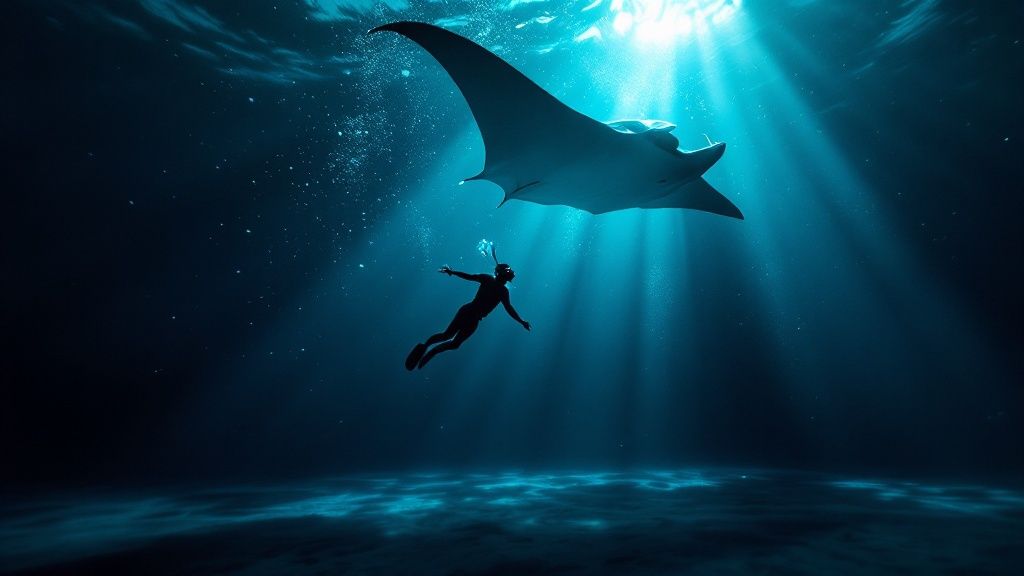
Picture this: you're floating on the calm, dark surface of the Pacific Ocean under the stars. Below you, powerful lights cut through the black water, attracting a blizzard of tiny plankton. Then, out of the darkness, they appear—giant, gentle manta rays, gliding and somersaulting in an otherworldly underwater ballet. This is the manta ray night snorkel in Kona, and it’s hands-down one of the most unforgettable wildlife encounters you can have anywhere on Earth.
Experience Kona's World-Famous Manta Ray Snorkel
Kona's coastline hosts one of the most magical wildlife experiences on the planet—a nighttime dance with giant manta rays. This isn't just watching nature from a distance; it's being right in the middle of the action. This guide will walk you through everything you need to know to see it for yourself.
We’ll cover what makes this snorkel so special, from the unique geography that creates a plankton buffet to the gentle giants that show up to feast on it.
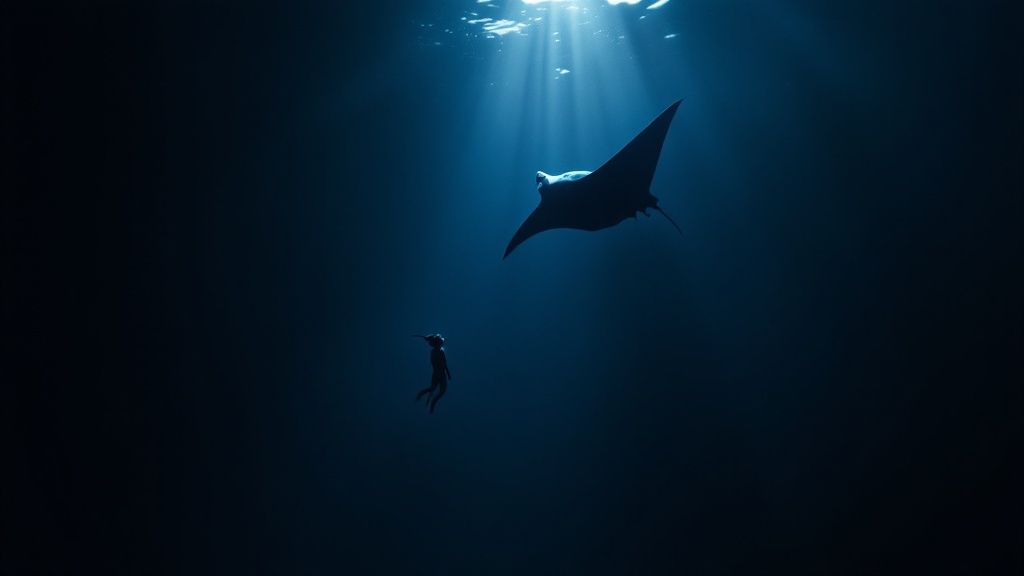
If you're ready for an adventure you'll be talking about for years, Kona Snorkel Trips is the top rated & most reviewed snorkel company in Hawaii, and they deliver an absolutely exceptional experience.
We will also introduce Manta Ray Night Snorkel Hawaii as an exceptional alternative for those exploring different top-tier tour options.
What Makes This Snorkel a Must-Do Activity?
The Kona Coast is globally recognized as the place for this adventure, home to a known population of over 450 resident manta rays. The whole experience works because tour boats bring powerful, submerged lights into the water. These lights attract clouds of plankton—the mantas' favorite food—creating a glowing, all-you-can-eat buffet that draws these gentle giants right up to the snorkelers.
You can learn more about the science behind the Kona Manta Ray Snorkel and why this spot is so unique.
This brilliant setup turns a simple night snorkel into an immersive spectacle. Unlike a lot of wildlife tours where sightings are hit-or-miss, the Kona snorkel has an incredibly high success rate, often topping 90% year-round. You aren't just watching from afar; you're floating inches above the action.
The feeling of a 12-foot manta ray gliding just beneath you is something you truly have to experience to understand. It's a mix of pure awe, total tranquility, and a profound connection to the ocean.
An Unforgettable Underwater Ballet
What truly captivates everyone, from first-time snorkelers to seasoned divers, is the sheer grace of the mantas. They perform these effortless barrel rolls and somersaults, their massive wingspans creating a mesmerizing dance in the illuminated water. This isn't just about feeding; it's a display of natural, wild elegance.
Ready to join this incredible underwater performance? Book your spot and get ready for an evening you will never, ever forget.
How to Choose the Right Manta Ray Tour
Let's be real: not all manta ray tours are created equal. Your choice of operator can genuinely make or break this once-in-a-lifetime experience. It's about so much more than just the price tag. Things like the size of the boat, how much support you get in the water, and whether the company actually cares about the mantas will shape your entire night.
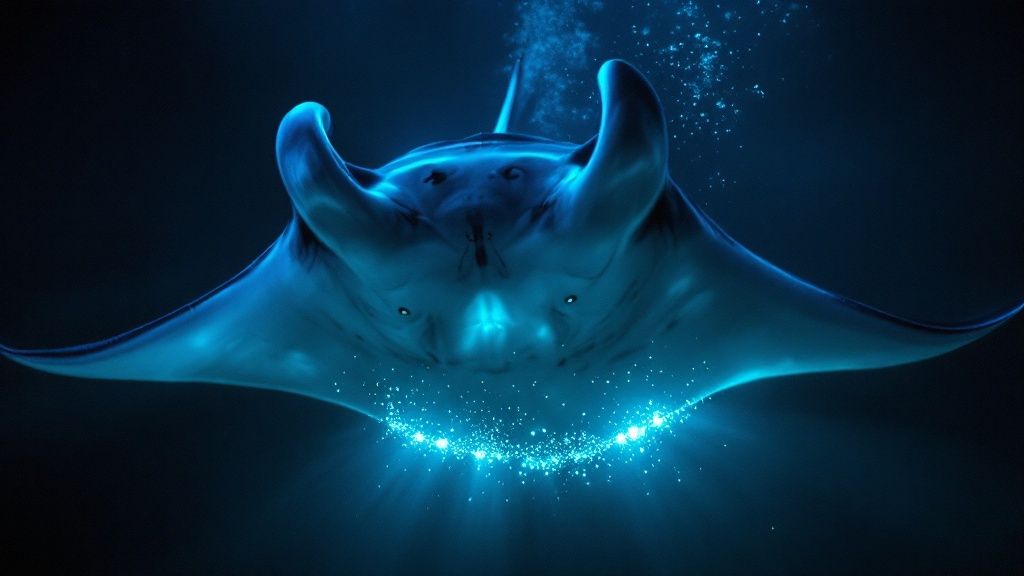
From my experience, most people have a much better time on smaller group tours, like the ones we run at Kona Snorkel Trips. Fewer people in the water means a better view for everyone and more one-on-one attention from the guides. That’s a huge factor when you're doing a manta ray night snorkel in Kona.
Group Size and Boat Type Matter
The first thing you’ll want to look at is the tour size. Big boats can pack in dozens of people. While that might sound like a party and can be easier on the wallet, it often leads to a crowded, chaotic time in the water where you're jockeying for position.
Smaller boats, on the other hand, offer a much more intimate vibe. You actually get to chat with the guides and feel more connected to what's happening around you. If you're weighing your options, checking out different Big Island snorkeling tours can give you a good sense of the variety out there.
The type of boat is also a factor. Some companies use large, stable catamarans, which are fantastic if you’re worried about seasickness. Others, like us, use smaller, nimble vessels that get you to the snorkel site faster for more time in the water.
To help you decide, here's a quick look at how these different tour styles stack up.
Comparing Manta Ray Night Snorkel Tour Options
This table breaks down what you can typically expect from the two main types of manta ray tours available in Kona.
| Feature | Small Group Tours (e.g., Kona Snorkel Trips) | Large Vessel Tours |
|---|---|---|
| Guest Count | Usually 6-12 people for a more personal feel. | Can be 25-60+ people. |
| In-Water Experience | Less crowded viewing board, better photo/video opportunities. | Can be crowded, potentially limiting your view. |
| Guide Interaction | High level of personal attention and guidance. | Less direct interaction due to the high guest-to-guide ratio. |
| Pace & Vibe | More relaxed and intimate, feels like a private charter. | Can be more social and high-energy, but also more chaotic. |
| Best For | Families, photographers, nervous swimmers, or anyone seeking a calm, premium experience. | Budget travelers, large social groups, and those who don't mind a crowd. |
Ultimately, your choice depends on the kind of night you want to have. Do you prefer a calm, personal encounter or a lively, social event?
The Importance of Ethical Operations
Beyond the logistics, the operator’s commitment to the manta rays' well-being is everything. We have a shared responsibility to make sure these incredible animals are protected so future generations can experience this magic.
Always look for companies that follow established guidelines for safe and respectful interaction. This isn't just a suggestion; it's crucial for the health of our local manta population.
A great sign of a responsible operator is their certification on the Manta Ray Green List. This means they're committed to the highest standards of safety for both the animals and guests, including strict no-touching policies and teaching everyone about proper "manta manners."
Before you click "book," do yourself a favor and read recent reviews. Hearing from past guests is the best way to get a real feel for a company's professionalism, safety record, and the overall quality of their tour.
Going with a top-rated, responsible company ensures you're not just another tourist, but a respectful guest in the mantas' underwater world.
Ready to book an experience with a company that puts small groups and responsible tourism first?
Preparing for Your Snorkel Adventure
Knowing a little about what to expect before your manta ray night snorkel in Kona can turn a good trip into an absolutely incredible one. Honestly, the prep is pretty simple, but getting it right sets the stage for a smooth, stress-free evening where your only job is to be amazed by the spectacle below. From the moment you arrive to your time in the water, the whole experience is built around safety and wonder.
Your adventure will kick off at a designated check-in spot, which is usually a harbor or a dive shop. This is where the friendly crew will greet you, get you checked in, and fit you for all the essential gear. It’s the perfect time to ask any last-minute questions that might be bouncing around in your head.
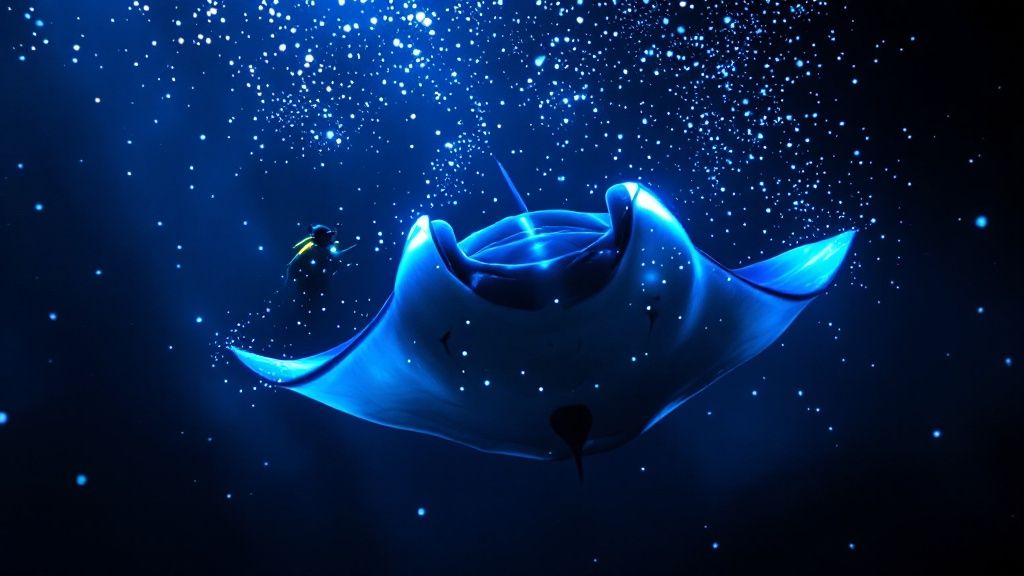
What to Bring (and What’s Already Covered)
Here’s the great news: your tour operator provides all the critical equipment. You don't need to stress about bringing your own snorkel, mask, fins, or wetsuit. And you’ll definitely appreciate the wetsuit—it provides both buoyancy and much-needed warmth, keeping you comfortable in the cooler nighttime ocean water.
For more details on gear, check out our complete guide: https://konasnorkeltrips.com/blog/gear-for-snorkeling-on-the-big-island-hawaii/
Your personal packing list is refreshingly minimal:
- A Towel: You’ll be glad you have it for drying off after the snorkel.
- Dry Clothes: Pack something warm and comfy to change into for the boat ride back. A sweatshirt or light jacket is a fantastic idea, as it can get chilly once you’re out of the water.
- Reef-Safe Sunscreen: Definitely bring this if your tour departs before sunset.
- Reusable Water Bottle: Staying hydrated is always a good plan.
- Underwater Camera: If you have one, make sure it’s fully charged and ready to capture the magic.
Once everyone is checked in and geared up, you'll hop on the boat for a short ride out to the snorkel site. This trip is part of the experience, offering stunning views of the Kona coast as the sun begins to set.
The Briefing and Your Floating Viewing Platform
Before anyone gets in the water, your guides will run through a thorough safety briefing. They’ll cover everything from how to use your gear correctly to the absolute golden rule of manta encounters: passive observation and no touching.
They’ll also explain the genius behind the underwater light raft.
This custom-built raft is the centerpiece of the whole operation. It’s basically a floating viewing platform that you hold onto, so you’re stable and secure on the surface. Powerful lights shine down from the bottom of the raft, attracting tiny plankton, which in turn draws in the magnificent manta rays for their dinner.
You just float, watch, and let the magic unfold right beneath you. It’s a simple, brilliant system that ensures you feel confident and fully prepared for an unforgettable night.
Getting to Know Kona's Manta Rays (And How to Be a Good Guest)
Jumping in the water for a manta ray night snorkel in Kona is so much more than just another tour. It’s a genuine, up-close interaction with incredible wildlife in their own world. To really make the most of it, it helps to understand a little bit about why this magical encounter even happens and how we can be respectful guests. The whole thing is a beautiful dance between nature and responsible tourism.
So, how does it work? The magic starts with some pretty simple science: lights attract plankton. Our tour boats shine powerful (but eco-friendly) lights down into the water, creating a glowing, dense cloud of tiny organisms. For Kona's resident manta rays, this illuminated buffet is basically a dinner bell they can't resist, drawing them in to feed in what looks like a mesmerizing underwater ballet.
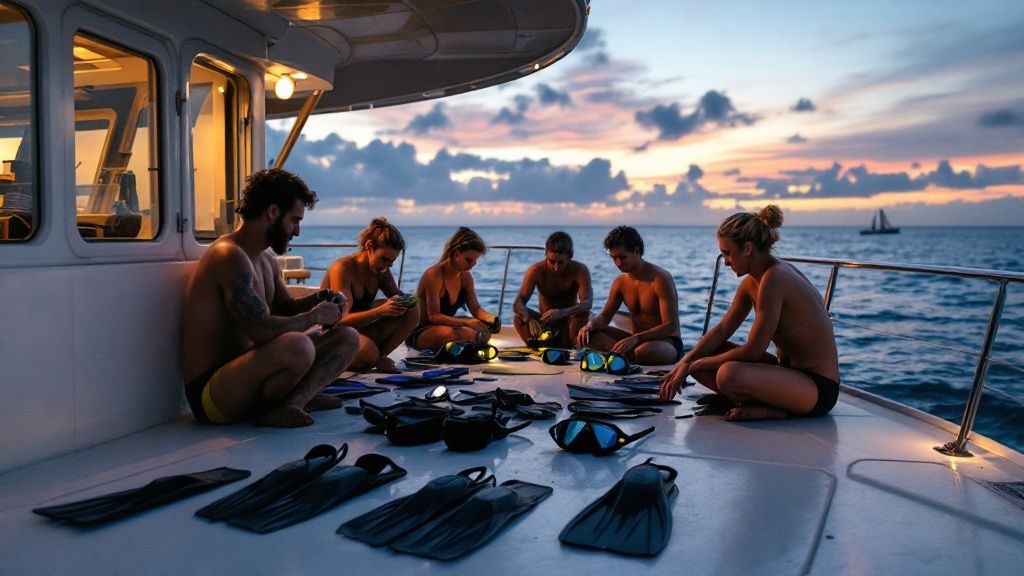
Kona's Top Manta Ray Hangouts
While you might spot mantas along the coast, there are two spots that have become famous for consistent, incredible sightings. Each one offers a slightly different vibe, mostly because of its unique underwater landscape and history.
-
Manta Village (Keauhou Bay): This is the OG viewing site, located just a bit south of Kailua-Kona. Its reputation for reliability is legendary, with great sightings pretty much year-round. Because it’s a bit shallower with a sandy bottom, it's a fantastic spot for both snorkelers and divers.
-
Manta Heaven (Garden Eel Cove): You'll find this spot north of Kona, out toward the airport. It's known for sometimes hosting huge groups of mantas. The visibility can be absolutely spectacular here, creating a dramatic, deep-blue stage for their feeding frenzy.
So, which one is "better"? It depends on the night. Data collected from the different sites shows that 'Manta Heaven' can average around 11 manta rays per night, with a success rate hovering near 90%. 'Manta Village' averages closer to 4 mantas a night but is often praised for being incredibly consistent. You can always check out more detailed stats on Big Island manta sightings to see the latest trends.
The Golden Rules: Manta Manners 101
The absolute heart of a safe and ethical manta ray encounter is respect. These are gentle, intelligent creatures. They don't have teeth, stingers, or barbs, so they pose zero threat to us. But our actions, even unintentional ones, can harm them. That's why every reputable tour operator enforces what we call "Manta Manners."
The most important rule of all? Passive observation. Think of yourself as a guest in their dining room. Your job is simply to float, watch, and be completely amazed—never to interfere.
Following these simple guidelines keeps the mantas safe and makes the experience better and safer for everyone in your group:
- Look, Don't Touch: This is the big one. Manta rays have a special mucus coating on their skin that acts like an immune system, protecting them from infection. Touching them strips this layer off, leaving them vulnerable to disease.
- Stay at the Surface: As a snorkeler, your place is at the surface, holding onto the light board. Trying to dive down can mess with the mantas' feeding patterns and just makes things chaotic for everyone.
- Still Fins, Please: Try your best not to kick or splash. Your wetsuit and the flotation board will keep you perfectly buoyant. Just relax and float.
- Let Them Come to You: Never, ever chase a manta ray. If you stay calm and still, they'll often get curious and glide just inches below you on their own terms. It’s a moment you’ll never forget.
By understanding their behavior and sticking to these crucial rules, you're doing your part to protect Kona's beloved manta ray population. You're helping ensure that this incredible experience will be around for generations to come.
Insider Tips for an Unforgettable Night
Alright, you're booked and ready to go. While the crew will give you a fantastic briefing before you hit the water, I've got a few extra tips that can turn an amazing trip into something you'll talk about for the rest of your life. These are the little things we guides and regulars have picked up over thousands of hours in the water with these gentle giants.
Getting Comfortable for the Long Haul
Even with a top-notch wetsuit, you can start to feel a little chill after floating for a while. Here's a pro move: just before you get in, splash a little bit of ocean water inside your wetsuit. I know, it sounds counterintuitive! But your body heat will warm up that thin layer of water almost instantly, creating a perfect insulating barrier to keep you toasty.
Another thing that can ruin the view is a foggy mask. Your tour operator will have some defog solution, so be sure to use it. And whatever you do, fight the urge to touch the inside of the lenses with your fingers. A clear mask is your window to the whole underwater ballet.
Where to Be for the Best Views
When you get to the light board, where you hang on actually matters. Try to snag a spot on one of the corners. Why? Mantas glide in these huge, sweeping arcs, and being on a corner gives you a wider, less-obstructed view. You'll see them coming from farther away and watch them disappear into the darkness. It's a game-changer.
Once you're in position, think "pancake." You want your body as flat and horizontal as possible on the surface. This isn't just about giving the mantas more room; this calm, passive posture is what invites them to glide right underneath you for those heart-stopping, inches-away fly-bys.
Capturing the Moment Without Ruining It
Bringing an underwater camera is a great idea, but please, please turn off the flash. The sudden burst of light can really startle the mantas. The powerful lights on the raft provide all the illumination you need for stunning photos and videos.
My most important piece of advice? Put the camera down for a few minutes. Just float. Let yourself be completely in the moment. The feeling of pure awe when a 12-foot giant does a graceful somersault right below you is a memory no photo can ever truly capture.
The only reason we can have these consistent, magical encounters is thanks to the incredible site fidelity of Kona's manta ray population. Researchers have used underwater videography for years to track individual mantas, learning so much about their behavior. If you're curious about the science behind the magic, you can read more about the fascinating research on Kona's mantas.
Ultimately, it all comes down to being a calm, respectful observer. The more relaxed and present you are, the more incredible this experience will be.
Common Questions About the Manta Ray Snorkel
Even after getting all the details, it's completely normal to have a few last-minute questions bubbling up before you commit. We get it. To help you book with total confidence, we've pulled together the most common questions we hear from travelers.
Here are some quick, straight-to-the-point answers to put your mind at ease.
Do I Need to Be a Strong Swimmer?
This is easily the number one concern, and the answer is a big, reassuring no. You absolutely do not need to be an expert swimmer, or even a particularly strong one, to have an amazing time.
Tour operators outfit you with high-quality wetsuits that make you incredibly buoyant—you’ll float with ease. Plus, you'll be holding onto a large, stable flotation board with handles. Your only job is to relax, float, and enjoy the incredible manta ballet happening right beneath you. As long as you're comfortable putting your face in the water with a mask on, you're good to go.
Is the Manta Ray Night Snorkel Safe?
Absolutely. When you go out with a professional, reputable tour company, this is a very safe activity. There's a reason manta rays are called "gentle giants." They're filter feeders and have no teeth, stingers, or barbs whatsoever. They are completely harmless to humans.
The real focus on safety comes down to following the clear instructions from your experienced guides. The boats are loaded with all the required safety gear, and the crews are professionally trained in first aid and water rescue. You’re in very capable hands from the moment you step on board.
What Is the Best Time of Year to See Mantas?
This is one of the best parts about this whole experience: you can do it any time of year! Kona is home to a massive, resident population of manta rays that stick around all year long. They don't migrate.
Because of this, manta sightings are incredibly consistent, no matter what month you decide to visit. Most tour operators report a success rate between 80-90% year-round. The crews are constantly watching ocean conditions and will only take you out when it's safe.
For a deeper dive into this and other common questions, check out our comprehensive list of manta ray FAQs to learn more.
Can Children Participate in the Tour?
Yes! The manta ray night snorkel can be a truly unforgettable experience for the entire family. Most tour companies are happy to welcome kids, though there's usually a minimum age requirement, often somewhere between 5 to 7 years old. It's always a good idea to check the specific policy with the tour operator you book with.
The most important thing is simply that the child is comfortable being in the ocean at night and can calmly follow the crew's safety instructions. If they can do that, you’re setting them up for a magical adventure they'll talk about for years.
Ready to experience the magic for yourself? Join Kona Snorkel Trips, Hawaii's highest-rated and most-reviewed snorkel company, for an adventure you will never forget.
Learn more about the Manta Ray Snorkel Kona tour and book your spot today!
